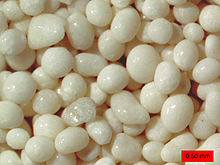
Aragonite
 Aragonite is a calcium carbonate mineral (like limestone) that comes from seashells. It is used in lieu of lime in situations where the soil is already high in magnesium, and where dolomite (high magnesium limestone) is the only liming material available. Aragonite has approximately 94-97 percent of the neutralizing value of CaCO3. Applications should be made in accordance with a soil test.
Aragonite is a calcium carbonate mineral (like limestone) that comes from seashells. It is used in lieu of lime in situations where the soil is already high in magnesium, and where dolomite (high magnesium limestone) is the only liming material available. Aragonite has approximately 94-97 percent of the neutralizing value of CaCO3. Applications should be made in accordance with a soil test.
Aragonite can also used to protect newly planted bulbs from damage caused by moles, mice, chipmunks, and squirrels. Aragonite is often used as a soil conditioner and feed supplement and is not registered as a fertilizer.
Aragonite is also used as a feed ingredient for chickens.
Aragonite is comprised of various mollusk shells, gathered from the ocean floor, and, typically, contains no more than 15% oyster shell. The mollusks are pulverized by the ocean’s waves, the debris settles on the ocean floor and then is harvested.
Oolitic aragonite sand forms in tropical waters. Most of the topography of the Bahama Banks is comprised of calcium carbonate oolitic aragonite sand material. The natural formation through precipitation and sedimentation of aragonite sand in the Bahamas surpasses anyplace else in the world. There are billions of tons of this type of sand material in reserve and millions of tons more naturally created annually.
Aragonite is generally regarded as safe (GRAS). There is no SDS (MSDS) available for this material.
 North Country Organics
North Country Organics